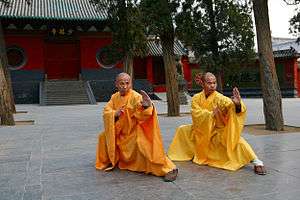Chinese swordsmanship
Chinese swordsmanship encompasses a variety of sword fighting styles native to China. No Chinese system teaches swordsmanship exclusively (as is the case with modern sports such as fencing or kendo), but many eclectic schools of Chinese martial arts include instruction for using one or two-handed versions of the single-edged sword (dao) and the double-edged sword (jian).
| Part of a series on |
| Chinese martial arts (Wushu) |
|---|
 |
| Wushu in the world |
|
Historical locations
|
| Wushu athletes/practitioners |
|
Legendary figures
|
|
Historical individuals
|
|
Modern celebrities
|
| Wushu influence |
Many Chinese martial arts styles teach swordsmanship. Wudang Sword is an umbrella term for all sword styles taught in the Wudang chuan family of martial arts. Taijijian is the swordsmanship taught within Taijiquan.
Shuangdao (simplified Chinese: 双刀; traditional Chinese: 雙刀) is the Chinese term for the wielding of two dao simultaneously.
See also
- Butterfly sword
- Nandao
- Eighteen Arms of Wushu
- Japanese swordsmanship
- Korean swordsmanship
- French school of fencing
- German school of fencing
- Italian school of fencing
Sources
- Zhang Yun, The Complete Taiji Dao: The Art of the Chinese Saber, Blue Snake Books, ISBN 978-1-58394-227-7
- Zhang Yun, Art Of Chinese Swordsmanship: Manual Of Taiji Jian, Weatherhill, ISBN 978-0-8348-0412-8
This article is issued from Wikipedia. The text is licensed under Creative Commons - Attribution - Sharealike. Additional terms may apply for the media files.